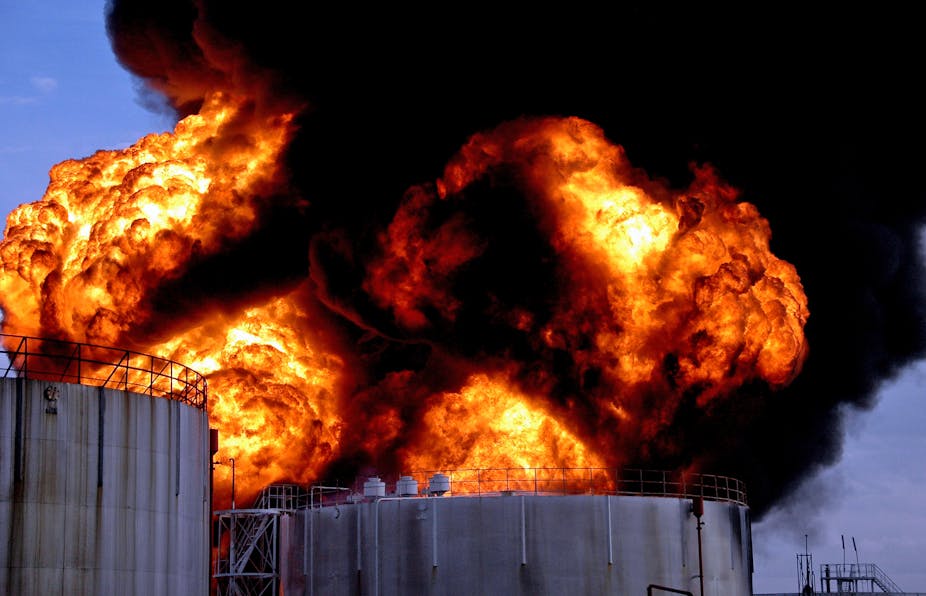Syria’s opposition and rebels have taken a string of cities and towns from the Syrian military since the start of 2015, but thanks to pressure from the Islamic State (IS) and the Assad regime, they are facing devastating shortages of fuel.
Syria has been beset by a crisis over oil and gas supplies amid the escalation of the four-year conflict, with the Assad regime losing almost all of its oil fields and about half of its gas fields to IS. Damascus has been forced to cut subsidies, further raising prices for businesses and residents – but the shortages on the government side have been mitigated by IS’s regular sales of fuel to the regime.
In contrast, IS has imposed a cut-off on the rebels, which it has been battling since January 2014. In northern Syria, IS has not only refused to sell the rebels oil and gas, but has blocked long-time smugglers from doing so.
Cut off
As the opposition has consolidated its control of newly captured areas – notably in Idlib Province, but also in other territory extending into central Syria – it has taken control of agriculture, factories, businesses, aid deliveries, bakeries, water supply, and infrastructure such as hospitals. The lack of fuel is making those services almost non-functional – and the price of bread has doubled and even tripled in only a few weeks. Petrol prices have also tripled.
On June 16, Syrian civil defense teams issued a call for help from humanitarian organisations, as well as a token appeal to “all those responsible for the fuel crisis” to ease the restrictions. The head of civil defense, Raed a-Salih, confirmed that the crisis had “all but paralyzed” rescue work.
In northern Hama Province, the rebel-affiliated Health Administration declared the suspension of all hospital and clinic work from Monday because of the diesel crisis. A Syrian Civil Defence worker told me 14 newborn children had died at a hospital in Maarat al-Numan because there was no fuel for incubators: “We’ve stopped everything other than ambulance work. We can’t use our machines to get people out of the rubble after bombings anymore - there’s no fuel for it. So we’ve gone back to digging them out by hand.”
“Diesel has been cut off for two weeks because IS is not allowing convoys to pass from the eastern regions,” media activist Hukm Abu Riyan said. “They’re cutting off the heads of fuel truck drivers heading to the area.”
One activist tweeted that the price of diesel was now 550 Syrian Pounds SYP (about $1.80) per litre, in an area of northern Syria where the average monthly salary is 15,000 SYP (about $500). He concluded that IS “put their hands on all the country’s resources while the people go hungry.”
The Idlib News Network confirmed the account in a “call of distress”, putting the price of diesel at 600 SYP (about US$2.00) per litre. It said the situation had been worsened by continued regime bombing and shelling, retaliating for losses on the ground and hoping to break infrastructure: “We do not see bread as usual, and hospitals are no longer working.” Shaam News Network added that the Syrian military is blocking fuel trucks from entering rebel-held territory.
Cry for help
The pain is unlikely to ease any time soon. While the Assad regime and IS are not working together, they both see the rebels as their main adversaries. Faced with rapid rebel advances in both the northwest and south of Syria – including the capture of a provincial capital, other cities, and large military bases – Damascus will maintain its blockade.
Equally, IS has launched an offensive in northern Aleppo Province and is protecting its control of resources. So it’s unlikely ever to treat the opposition with the almost businesslike approach in which “supplies to regime areas seem to remain unchecked”.
A local source I spoke to confirmed the claims that IS has been beheading smugglers to enforce the cut-off, and said “This is part of a plan to starve off the north after the rebel coalition Jaish al-Fateh made all its advances and the battles in Aleppo began against both ISIS and the regime. I don’t see a solution besides taking the war to the oilfields, whether they are controlled by the Islamic State or Damascus.”
Meanwhile, the hopes for relief from outside the country are also slim. NGOs have only just started to ask local representatives for plans. Agencies in Turkey have no fuel tankers, and insufficient access to barrels to bring in supplies with cargo trucks — only the Turkish military has the equipment in place to draft and execute short-term relief, but it is bound by legal constraints. Any deliveries must also contend with Assad’s air strikes; convoys of fuel tankers are extremely vulnerable to aerial attacks, and at the moment there’s no-one willing to provide air cover for shipments.
Is there any consolation? A local activist told me that “The situation in the north is still way better than in besieged areas like East Ghouta and Western Ghouta [near Damascus], districts in south Damascus, or al-Waer in Homs – where people literally die like flies from starvation, lack of medicine, or heat.”

